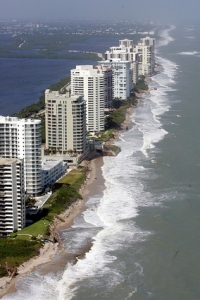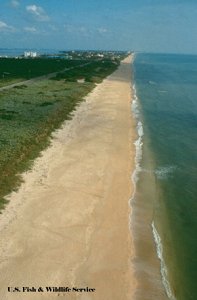This section describes some of the major threats to Florida’s coastal habitat and wildlife. The one thing that all of these threats have in common is that they are primarily caused by humans. While it is disturbing to know that our own actions can have such negative impacts, the fact that we are to blame leaves hope that we, as humans, can change our behavior to protect the resources we enjoy so much and depend upon.
 Rapid coastal development threatens the future of Florida’s beach and dune ecosystems. As new houses and condominiums are built on beaches and barrier islands, many fragile and important coastal communities are being lost forever. Unfortunately, as more and more people move into the state, many of them gravitate toward the coastline–resulting in even faster rates of development. The gradual disruption of coastal habitat not only affects the survival of plant and animal species, but also reduces the overall health of coastal ecosystems.
Rapid coastal development threatens the future of Florida’s beach and dune ecosystems. As new houses and condominiums are built on beaches and barrier islands, many fragile and important coastal communities are being lost forever. Unfortunately, as more and more people move into the state, many of them gravitate toward the coastline–resulting in even faster rates of development. The gradual disruption of coastal habitat not only affects the survival of plant and animal species, but also reduces the overall health of coastal ecosystems.
 Coastal armoring, such as sea walls, rock revetments and other man-made structures, can negatively affect coastal ecosystems and wildlife by interfering with natural beach shaping forces and disturbing habitat–especially sea turtle nesting habitat. Armoring is built in an effort to slow or prevent the erosion of sand in front of houses or other coastal structures. Unfortunately, sea walls provide only temporary relief from the natural process of erosion and often increase the rate of erosion on adjacent sections of beach. As erosion and sea-level rise puts more coastal structures at risk, armoring will become even more of a problem in Florida. Learn about the threat of coastal armoring to sea turtles…
Coastal armoring, such as sea walls, rock revetments and other man-made structures, can negatively affect coastal ecosystems and wildlife by interfering with natural beach shaping forces and disturbing habitat–especially sea turtle nesting habitat. Armoring is built in an effort to slow or prevent the erosion of sand in front of houses or other coastal structures. Unfortunately, sea walls provide only temporary relief from the natural process of erosion and often increase the rate of erosion on adjacent sections of beach. As erosion and sea-level rise puts more coastal structures at risk, armoring will become even more of a problem in Florida. Learn about the threat of coastal armoring to sea turtles…
 Beach nourishment consists of pumping, trucking or otherwise depositing sand on a beach to replace what has been lost to erosion. when done correctly and in accordance with all laws to protect sea turtles and other natural resources, beach nourishment can add nesting habitat where erosion had washed it away. It is worth noting that a very wide beach resulting from nourishment is generally only beneficial to sea turtles in those areas where limited or degraded nesting habitat had previously existed. Learn about the threat of beach erosion to sea turtles…
Beach nourishment consists of pumping, trucking or otherwise depositing sand on a beach to replace what has been lost to erosion. when done correctly and in accordance with all laws to protect sea turtles and other natural resources, beach nourishment can add nesting habitat where erosion had washed it away. It is worth noting that a very wide beach resulting from nourishment is generally only beneficial to sea turtles in those areas where limited or degraded nesting habitat had previously existed. Learn about the threat of beach erosion to sea turtles…
 Inlets provide ocean access for recreational and commercial boats. Jetties, such as those at Sebastian Inlet, are built to stabilize inlets by trapping sand that would otherwise constantly reshape the inlet. Unfortunately, by trapping sand, jetties prevent the natural flow of sand along a coastline–causing the beach on one side of the inlet to erode faster than normal. Sometimes, sand can be “bypassed” around the inlet, but this process is very expensive.
Inlets provide ocean access for recreational and commercial boats. Jetties, such as those at Sebastian Inlet, are built to stabilize inlets by trapping sand that would otherwise constantly reshape the inlet. Unfortunately, by trapping sand, jetties prevent the natural flow of sand along a coastline–causing the beach on one side of the inlet to erode faster than normal. Sometimes, sand can be “bypassed” around the inlet, but this process is very expensive.
Coastal waters and beaches are under constant threat from pollution. Coastal ecosystems, such as lagoons, mangroves and salt marshes, are often polluted by runoff from the mainland. Rivers that empty into these coastal waters carry pollution from inland sources, such as runoff from lawns and farms. Pesticides, fertilizers, oil spills and sewage plant discharge are also factors leading to pollution of our coastal waters.
Coastal ecosystems can also be polluted by beach-goers. Beach driving results in oil and other toxic fluids being accumulated in the sand and eventually reaching the ocean. Litter left by beach visitors gets blown into the water and may be eaten by marine animals, including sea turtles. As pollutants accumulate over time, our oceans may eventually no longer be able to support the plants and animals that depend on them to survive.
Non-native, or exotic, vegetation has invaded many coastal areas. Most exotic species were introduced by humans as ornamental plants for landscaping. Invasive coastal species, such as Australian pine, melaluka and Brazilian pepper, out-compete Florida’s native plants, such as sea oak, sea grape and dune grass, degrading the quality of wildlife habitat. Invasion onto the coast by species that are less effective at stabilizing dunes also leads to increased beach erosion.

The Archie Carr Refuge represents the Nation’s most significant land acquisition effort to protect the world’s populations of marine turtles. The Refuge is an example of how coastal habitat can be protected. Unfortunately, rapid coastal development in Brevard and Indian River Counties threatens the future effectiveness of the Refuge. Supporters of the Refuge are literally in a race against time to acquire the best remaining parcels of undeveloped land.
The Archie Carr National Wildlife Refuge was designated by Congress in 1990 to protect sea turtles, now threatened with extinction throughout the world. Leading sea turtle researchers and concerned citizens have watched with increasing concern as turtle populations worldwide have plummeted due to over-exploitation and destruction of nesting habitat. The Carr Refuge offers hope for saving one of the most important sea turtle nesting sites in the world.
The twenty mile section of coastline from Melbourne Beach to Wabasso Beach in Florida is the most important nesting area for loggerhead sea turtles in the western hemisphere and the second most important nesting beach in the world. Twenty-five percent of all loggerhead sea turtle and 35% of all green sea turtle nests in the United States occur in this twenty mile zone. Nesting densities of 1,000 nests per mile have been recorded.
Learn more about the Archie Carr National Wildlife Refuge.